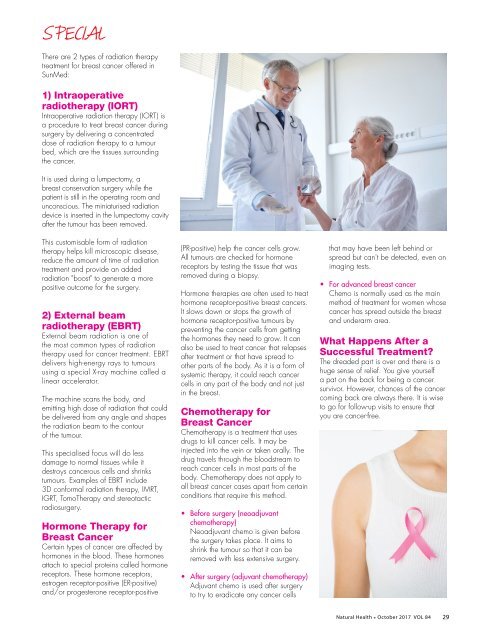Natural Health October 2017
Create successful ePaper yourself
Turn your PDF publications into a flip-book with our unique Google optimized e-Paper software.
SPECIAL<br />
There are 2 types of radiation therapy<br />
treatment for breast cancer offered in<br />
SunMed:<br />
1) Intraoperative<br />
radiotherapy (IORT)<br />
Intraoperative radiation therapy (IORT) is<br />
a procedure to treat breast cancer during<br />
surgery by delivering a concentrated<br />
dose of radiation therapy to a tumour<br />
bed, which are the tissues surrounding<br />
the cancer.<br />
It is used during a lumpectomy, a<br />
breast conservation surgery while the<br />
patient is still in the operating room and<br />
unconscious. The miniaturised radiation<br />
device is inserted in the lumpectomy cavity<br />
after the tumour has been removed.<br />
This customisable form of radiation<br />
therapy helps kill microscopic disease,<br />
reduce the amount of time of radiation<br />
treatment and provide an added<br />
radiation "boost" to generate a more<br />
positive outcome for the surgery.<br />
2) External beam<br />
radiotherapy (EBRT)<br />
External beam radiation is one of<br />
the most common types of radiation<br />
therapy used for cancer treatment. EBRT<br />
delivers high-energy rays to tumours<br />
using a special X-ray machine called a<br />
linear accelerator.<br />
The machine scans the body, and<br />
emitting high dose of radiation that could<br />
be delivered from any angle and shapes<br />
the radiation beam to the contour<br />
of the tumour.<br />
This specialised focus will do less<br />
damage to normal tissues while it<br />
destroys cancerous cells and shrinks<br />
tumours. Examples of EBRT include<br />
3D conformal radiation therapy, IMRT,<br />
IGRT, TomoTherapy and stereotactic<br />
radiosurgery.<br />
Hormone Therapy for<br />
Breast Cancer<br />
Certain types of cancer are affected by<br />
hormones in the blood. These hormones<br />
attach to special proteins called hormone<br />
receptors. These hormone receptors,<br />
estrogen receptor-positive (ER-positive)<br />
and/or progesterone receptor-positive<br />
(PR-positive) help the cancer cells grow.<br />
All tumours are checked for hormone<br />
receptors by testing the tissue that was<br />
removed during a biopsy.<br />
Hormone therapies are often used to treat<br />
hormone receptor-positive breast cancers.<br />
It slows down or stops the growth of<br />
hormone receptor-positive tumours by<br />
preventing the cancer cells from getting<br />
the hormones they need to grow. It can<br />
also be used to treat cancer that relapses<br />
after treatment or that have spread to<br />
other parts of the body. As it is a form of<br />
systemic therapy, it could reach cancer<br />
cells in any part of the body and not just<br />
in the breast.<br />
Chemotherapy for<br />
Breast Cancer<br />
Chemotherapy is a treatment that uses<br />
drugs to kill cancer cells. It may be<br />
injected into the vein or taken orally. The<br />
drug travels through the bloodstream to<br />
reach cancer cells in most parts of the<br />
body. Chemotherapy does not apply to<br />
all breast cancer cases apart from certain<br />
conditions that require this method.<br />
• Before surgery (neoadjuvant<br />
chemotherapy)<br />
Neoadjuvant chemo is given before<br />
the surgery takes place. It aims to<br />
shrink the tumour so that it can be<br />
removed with less extensive surgery.<br />
• After surgery (adjuvant chemotherapy)<br />
Adjuvant chemo is used after surgery<br />
to try to eradicate any cancer cells<br />
that may have been left behind or<br />
spread but can't be detected, even on<br />
imaging tests.<br />
• For advanced breast cancer<br />
Chemo is normally used as the main<br />
method of treatment for women whose<br />
cancer has spread outside the breast<br />
and underarm area.<br />
What Happens After a<br />
Successful Treatment?<br />
The dreaded part is over and there is a<br />
huge sense of relief. You give yourself<br />
a pat on the back for being a cancer<br />
survivor. However, chances of the cancer<br />
coming back are always there. It is wise<br />
to go for follow-up visits to ensure that<br />
you are cancer-free.<br />
<strong>Natural</strong> <strong>Health</strong> * <strong>October</strong> <strong>2017</strong> VOL 84<br />
29

















